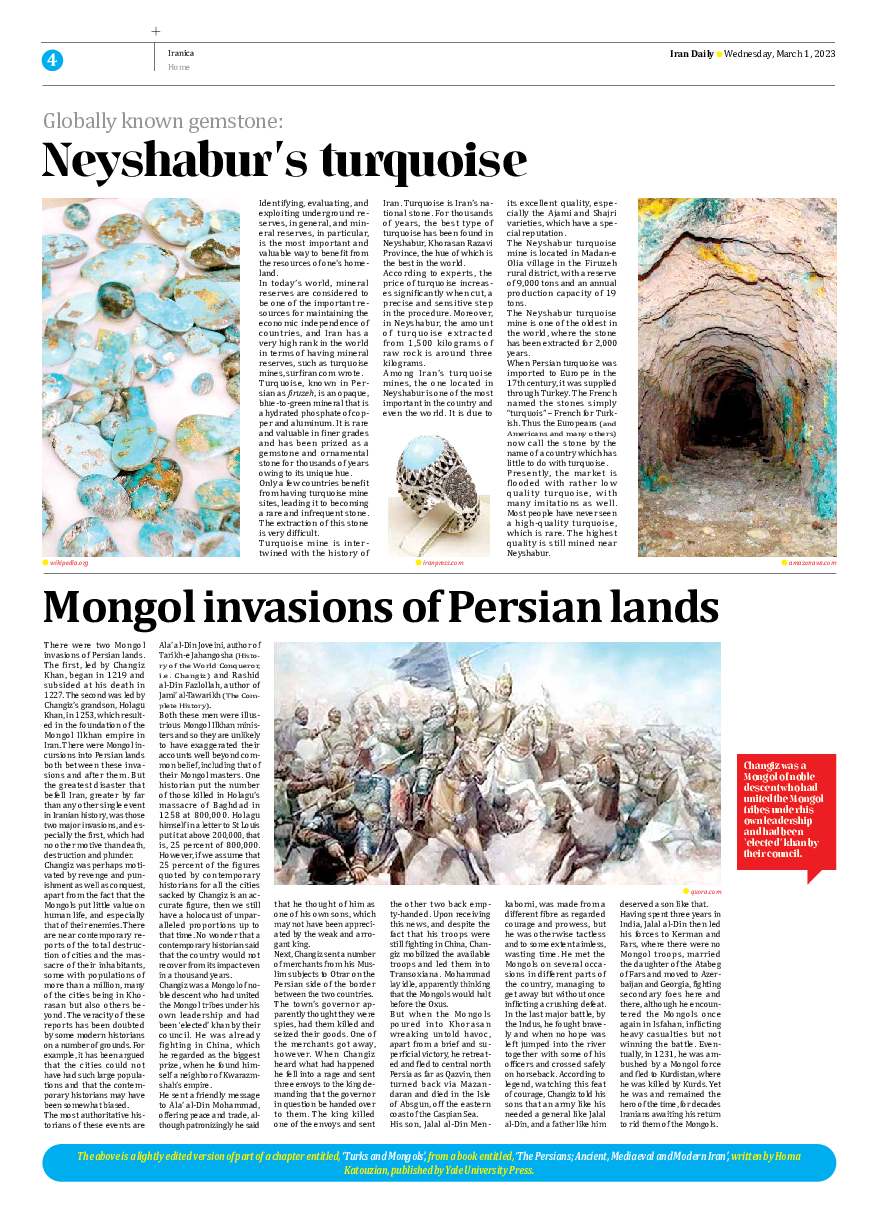
Mongol invasions of Persian lands
There were two Mongol invasions of Persian lands. The first, led by Changiz Khan, began in 1219 and subsided at his death in 1227. The second was led by Changiz’s grandson, Holagu Khan, in 1253, which resulted in the foundation of the Mongol Ilkhan empire in Iran. There were Mongol incursions into Persian lands both between these invasions and after them. But the greatest disaster that befell Iran, greater by far than any other single event in Iranian history, was those two major invasions, and especially the first, which had no other motive than death, destruction and plunder.
Changiz was perhaps motivated by revenge and punishment as well as conquest, apart from the fact that the Mongols put little value on human life, and especially that of their enemies. There are near contemporary reports of the total destruction of cities and the massacre of their inhabitants, some with populations of more than a million, many of the cities being in Khorasan but also others beyond. The veracity of these reports has been doubted by some modern historians on a number of grounds. For example, it has been argued that the cities could not have had such large populations and that the contemporary historians may have been somewhat biased.
The most authoritative historians of these events are Ala’ al-Din Joveini, author of Tarikh-e Jahangosha (History of the World Conqueror, i.e. Changiz) and Rashid al-Din Fazlollah, author of Jami’ al-Tawarikh (The Complete History).
Both these men were illustrious Mongol Ilkhan ministers and so they are unlikely to have exaggerated their accounts well beyond common belief, including that of their Mongol masters. One historian put the number of those killed in Holagu’s massacre of Baghdad in 1258 at 800,000. Holagu himself in a letter to St Louis put it at above 200,000, that is, 25 percent of 800,000. However, if we assume that 25 percent of the figures quoted by contemporary historians for all the cities sacked by Changiz is an accurate figure, then we still have a holocaust of unparalleled proportions up to that time. No wonder that a contemporary historian said that the country would not recover from its impact even in a thousand years.
Changiz was a Mongol of noble descent who had united the Mongol tribes under his own leadership and had been ‘elected’ khan by their council. He was already fighting in China, which he regarded as the biggest prize, when he found himself a neighbor of Kwarazmshah’s empire.
He sent a friendly message to Ala’ al-Din Mohammad, offering peace and trade, although patronizingly he said that he thought of him as one of his own sons, which may not have been appreciated by the weak and arrogant king.
Next, Changiz sent a number of merchants from his Muslim subjects to Otrar on the Persian side of the border between the two countries.
The town’s governor apparently thought they were spies, had them killed and seized their goods. One of the merchants got away, however. When Changiz heard what had happened he fell into a rage and sent three envoys to the king demanding that the governor in question be handed over to them. The king killed one of the envoys and sent the other two back empty-handed. Upon receiving this news, and despite the fact that his troops were still fighting in China, Changiz mobilized the available troops and led them into Transoxiana. Mohammad lay idle, apparently thinking that the Mongols would halt before the Oxus.
But when the Mongols poured into Khorasan wreaking untold havoc, apart from a brief and superficial victory, he retreated and fled to central north Persia as far as Qazvin, then turned back via Mazandaran and died in the Isle of Absgun, off the eastern coast of the Caspian Sea.
His son, Jalal al-Din Menkaborni, was made from a different fibre as regarded courage and prowess, but he was otherwise tactless and to some extent aimless, wasting time. He met the Mongols on several occasions in different parts of the country, managing to get away but without once inflicting a crushing defeat. In the last major battle, by the Indus, he fought bravely and when no hope was left jumped into the river together with some of his officers and crossed safely on horseback. According to legend, watching this feat of courage, Changiz told his sons that an army like his needed a general like Jalal al-Din, and a father like him deserved a son like that.
Having spent three years in India, Jalal al-Din then led his forces to Kerman and Fars, where there were no Mongol troops, married the daughter of the Atabeg of Fars and moved to Azerbaijan and Georgia, fighting secondary foes here and there, although he encountered the Mongols once again in Isfahan, inflicting heavy casualties but not winning the battle. Eventually, in 1231, he was ambushed by a Mongol force and fled to Kurdistan, where he was killed by Kurds. Yet he was and remained the hero of the time, for decades Iranians awaiting his return to rid them of the Mongols.
The above is a lightly edited version of part of a chapter entitled, ‘Turks and Mongols’, from a book entitled, ‘The Persians; Ancient, Mediaeval and Modern Iran’, written by Homa Katouzian, published by Yale University Press.







